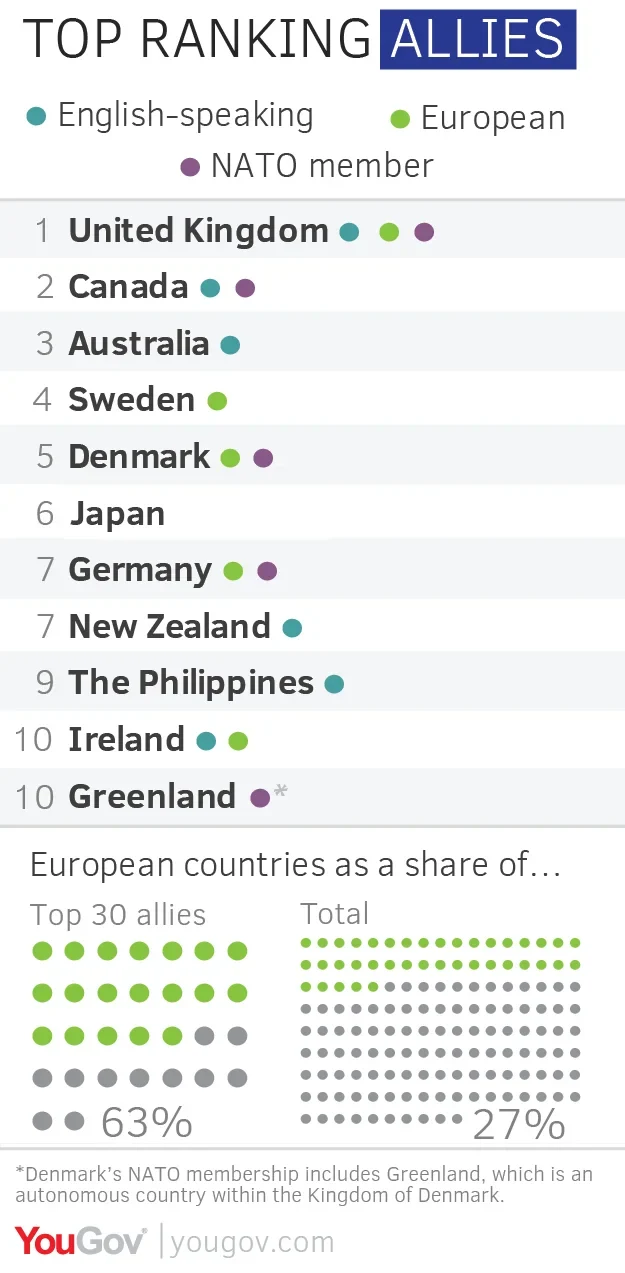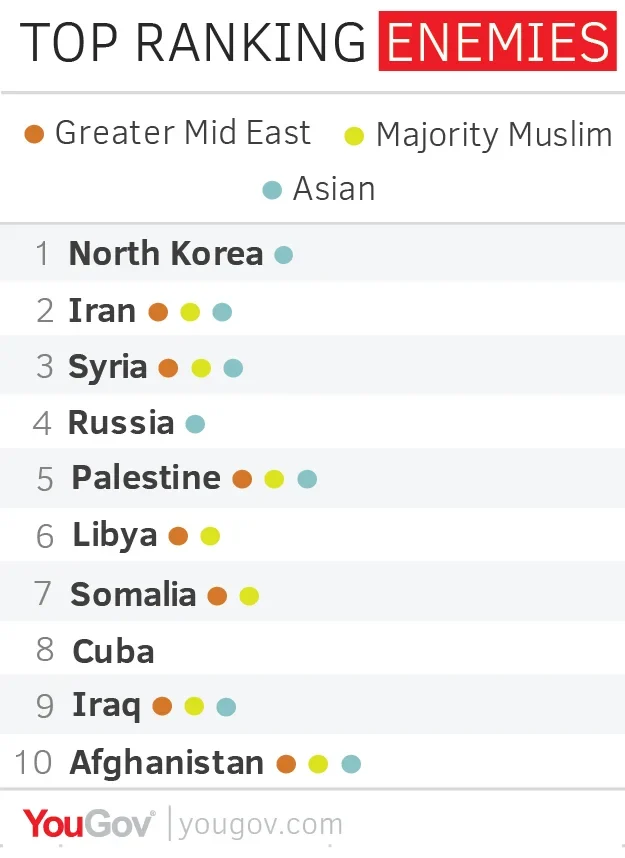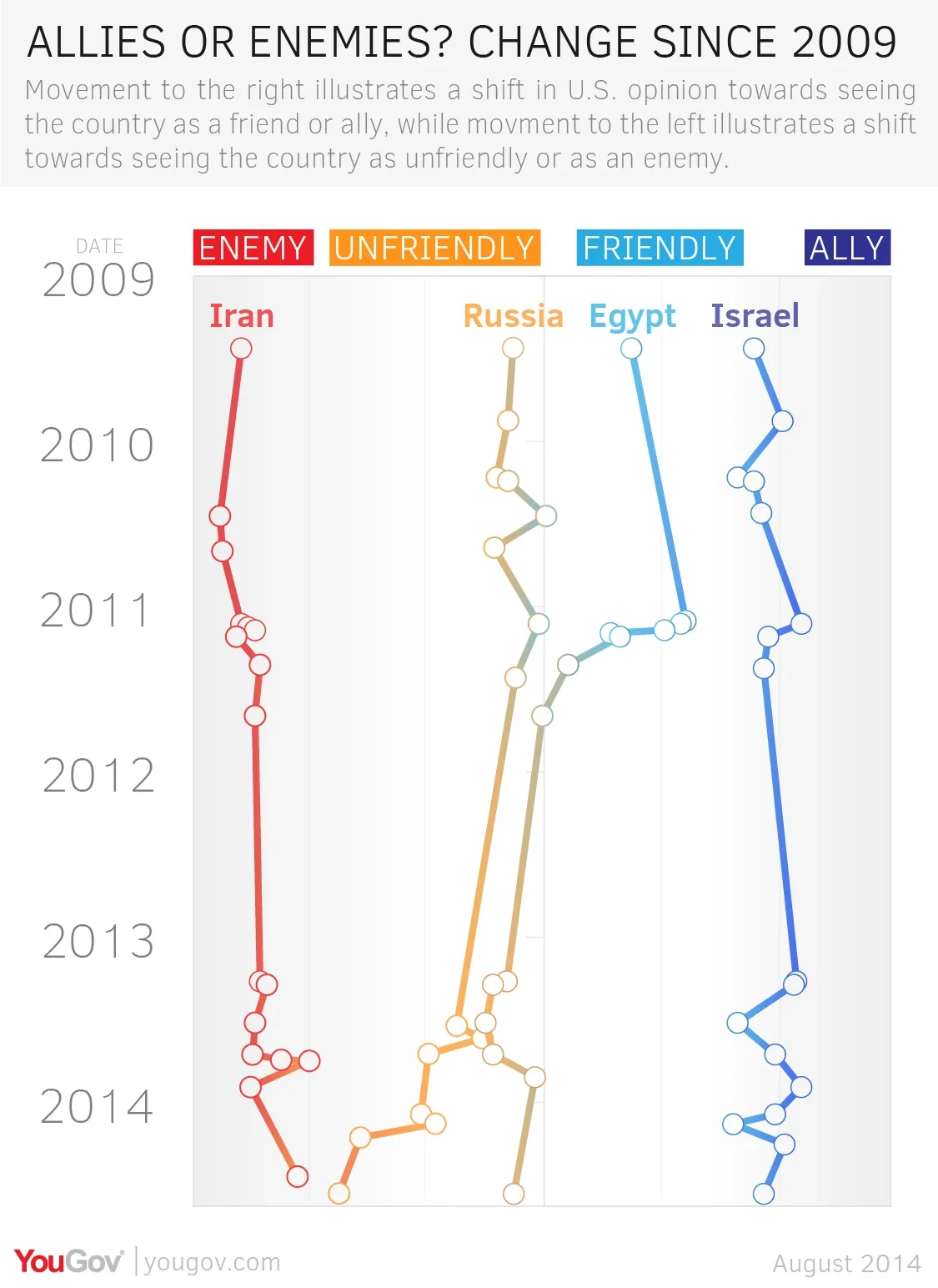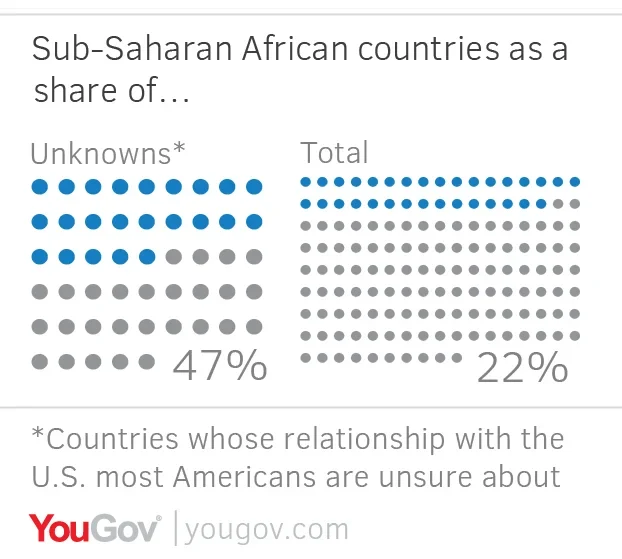The world seen through the eyes of Americans living today is a starkly divided place. On the one hand, Europe and English-speaking countries such as Canada, Australia and India are seen as allies; on the other, most of the Asian continent, from Siberia right through the central Asian states down to the Middle East and North Africa, is seen as unfriendly or actively hostile territory.
Special relationships

American allies overwhelmingly tend to be European countries and English-speaking countries. Every one of the top 10 falls into one of these two categories except Greenland.
The top three are all English-speaking and America’s greatest perceived ally is the United Kingdom, which is both English-speaking and European. The UK's high standing in the list – two-thirds (66%) of Americans see the country as an ally – confirm that, at least as a matter of public opinion, the "special relationship" is still going strong.
European countries also dominate beyond the top 10: no fewer than 19 of the top 30 allies are European, making up 63% of this friendly group despite European countries making up only 27% of the countries included in the map.
Most of these countries are also members of North Atlantic Treaty Organization (NATO), a military alliance between the United States and 27 other countries in North America and Europe. According to Article 5 of the North Atlantic treaty, member states are required to come to the aid of any other member if it is subject to an armed attack. All but five NATO members are seen as allies or friends by the American public (and the five exceptions receive mostly "not sure" responses rather than being seen as enemies).
But the top tier of allies is also spotted with countries that don't fall into these three categories. The exceptions are mostly found in Asia and the Pacific – Japan, South Korea and Taiwan. Central and South American countries largely come after the top 30 in the list, but are mostly seen amicably. Only four friends are found in Africa.
Israel, though not a member of NATO, is the United States' closest and one of its only military allies in the Middle East and notably comes high on the list as well. Given the history of military and diplomatic cooperation between the U.S. and Israel, Israel's 12th-place ranking behind the likes of Denmark and Sweden may come as a surprise. While many (44%) Americans see Israel as an ally (4 points lower than Canada), a small but significant group of Americans see Israel as unfriendly (10%) or as an enemy (4%). In comparison, no more than 3% put the UK, Canada, Australia, Sweden or Denmark in either of the negative categories.
In the red

The tight geographical grouping of America’s perceived adversaries gives the picture of a starkly divided world.
All but seven of 30 enemies can be found in Asia and Africa. They include the world’s largest countries by landmass (Russia) and population (China), and form an almost continuous 9,000-mile strip from the Bering Strait right across Asia and the Middle East through North Africa to the Atlantic.
After more than a decade of war in the region, fought largely against Islamic extremists, Middle Eastern and Muslim countries are highly over-represented among the countries Americans are most likely to see as enemies.
Seven of the top 10 in the “Greater” Middle East, which includes countries like Somalia and Libya, and over half (16) of the 30 have majority-Muslim populations. This includes both Iraq and Afghanistan, where the U.S. has devoted billions of dollars and thousands of lives to nation-building.
It also includes several countries – Syria, Libya, Yemen, Algeria, and Saudi Arabia – that underwent demonstrations or civil uprisings following the Arab Spring. Egypt, whose leader before the Arab Spring, Hosni Mubarak, was generally considered a friend to the United States, is essentially on the borderline, but falls very narrowly into the enemies’ camp. And YouGov’s data can show that views of many of these countries have worsened in recent years. When YouGov asked about Egypt in 2009, most people considered it either a friend (44%) or an ally (7%).

The opposite is true for Iran, which is now seen in a less negative light than in 2009. 41% call now call Iran an enemy, down from a peak of 53% in 2010. Since 2009 the United States has begun talks with Iran regarding its nuclear program, and Iran's vocally anti-American president Mahmoud Ahmadinejad has been replaced by Hassan Rouhani, a reformist. But in a testament to how badly Iran-US relations were perceived to begin with, it still ranks second among America's perceived enemies.
An even more dramatic shift has occurred with regard to Russia. As YouGov has previously shown, views of U.S.-Russia relations recently reached a new low. The trend predates but appears to have been accelerated by the annexation of Crimea by Russia. If Russia’s score from 2009 (-13) were used for the current map, it would rank around 24th, rather than 4th among enemies and unfriendly countries.
However, while Cold War-era foes dot the list – North Korea is in first place, with six in 10 (61%) calling it an enemy – these countries appear more like exceptions that prove the rule. If there is a center of gravity for the world's perceived "hostile territory", it seems to be in the Middle East.
Unknown Africa
There are also many countries which most Americans are unsure about, and a great deal of these countries are in Africa.
There were 32 Sub-Saharan African countries included in the survey; a majority of Americans responded “not sure” for 23 of them. Sub-Saharan Africa contains nearly half (46%) of all these 50 “unknown” countries despite accounting for only 22% of the 145 countries asked about.

Other regions do make appearances – for instance two Baltic states, despite both being NATO members, and four of the “Stans” (Turkmenistan, Uzbekistan, Kyrgyzstan and Tajikistan). But relations with countries on the African continent are by far the foggiest for Americans.
A country falling into the "unknown" category doesn't always mean it's a country most Americans haven't heard of. Around a third of Americans have consistently been "not sure" about Egypt between 2009 and 2013, a period during which Hosni Mubarak fell from power and the country oscillated from democracy to Islamic government and ultimately back to autocracy. This suggests that, in some cases, the uncertainties expressed are at least partly due to real ambiguities about U.S. relations with otherwise familiar states.
**
Overall, the map is a reminder that even in an increasingly globalized and interconnected world, much of it remains mysterious, unfriendly or downright hostile to many Americans. Events like the September 11th terrorist attacks, the wars in Afghanistan and Iraq, the Arab Spring and the annexation of Crimea have likely been reminders of this. At the same time, there are bright spots. Apart from Cuba, there are few enemies near American shores, and there are friends in all corners of the world.
Methodology
Between August 2013 and May 2014 (with one exception), YouGov added an extra question to many of its representative surveys of 1000 American adults. The question has five answer options and is asked about multiple countries at once. It reads:
Which of the following countries do you consider to be a friend or an enemy of the United States?
Respondents could answer “Ally of U.S.”, “Friendly”, “Unfriendly”, “Enemy of the U.S.” or “Not Sure” for each country listed.
The percentage giving each response is shown in the table above. The score is calculated by awarding two points for every percentage point saying a country is an “ally” one point for every percentage point saying they are “friendly”, negative one for “unfriendly” and negative two for “enemy.”
Each country falls into a group of net positive score (allies) or net negative score (enemies). In order to avoid misrepresenting countries where, in fact, most Americans have no well-defined opinion at all, countries with 51% or more “Not sure” responses were put in a separate category (unknowns) and scored on the basis of the proportion of responses beyond 50% that were “Not sure”.
Countries that featured prominently in the news such as Ukraine, Russia or Iran, were asked about multiple times to avoid going out of date.
The selection of the 145 countries was non-scientific, but the sample accounts for the majority of non-island countries in each continent (excluding Antarctica) and the vast majority of the world’s population. Certain states included have disputed statuses, such as the State of Palestine and Kosovo, but given their particular histories vis-à-vis the U.S., they have been treated as distinct.











